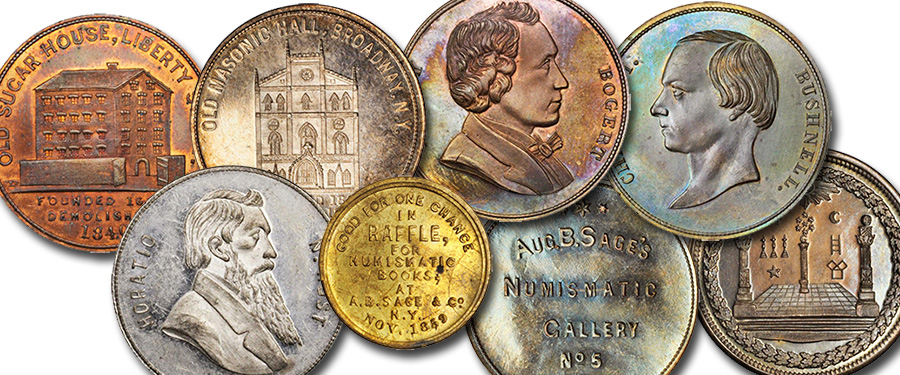
Stack’s Bowers Galleries is proud to announce the sale of the Q. David Bowers Reference Collection of Augustus B. Sage Medals in our official auction of the ANA World’s Fair of Money. The collection is featured in Internet Session 9, which crosses the block on Monday, August 19 beginning at 9:00AM PT. Click here to be brought to the first lot in the collection, and continue reading for some comments from the consignor, Q. David Bowers.
Comments from Dave:
With a degree of wistfulness I have consigned my reference collection of Augustus B. Sage medalets in the hope that a new generation of enthusiasts will enjoy these pieces as much as I have. If I were not 80 years old I would still seek new varieties! This catalog offers many treasures, with some duplicates to be offered in later sales. However, many in the present offering are unique in my possession and might be unique in an absolute sense. I once wrote a book chapter about Paul Morphy, the American chess wizard, after which I received several inquiries as to where the related Sage medalet could be purchased. But I could not help, as a decade or more can pass between offerings on the market.
As to the issuer: Augustus B. Sage was born in Middle Town (Middletown), CT, on May 13, 1841, the son of Robert and Catharine Sage. His father had come to America from England, and his mother was from New York State. Robert died late in the decade of Augustus’ birth. By 1849 or 1850, his widow and her children had moved to lower Manhattan and had taken up residence at 109 Avenue B, moving to 259 Delancey Street by the mid-1850s and to 121 Essex Street by 1857. In 1854 our 13-year-old subject, identified in city records as “A.B. Sage,” was earning wages as a primary grade teacher or assistant in Ward School No. 12 at 371 Madison Street in the Seventh Ward, where he remained for the next several years. It seems probable that by 1856, when Augustus B. Sage was only 15 years old, he had been bitten by the coin bug. The recorded story of Augustus B. Sage’s hobby-profession seems to commence circa 1856, although tradition has it that Sage may have played a part in the sale of the Peter Flandin Collection at the auction room of Bangs & Co. in June 1855. Perhaps he helped with the catalog as he was not listed as a buyer. About the year 1857 Sage became prominent in numismatics in New York City. The discontinuation of the copper cent and half cent created a nationwide wave of nostalgia, and all of a sudden, thousands of people wanted to learn more.
The New-York Dispatch took a particular interest, and in 1857 Augustus, now 17 years old, using his youthful knowledge and enthusiasm plus extensive reading, set forth to educate readers of the Dispatch., He became a popular columnist—the first in American numismatic history – and his column drew wide interest. Although it is hard to imagine today, in 1857 and 1858 there were no books at all on federal coins. By 1858 Augustus Sage started dealing in coins in a small way, with Henry Bogert as a partner. Tokens and medals interested him in particular. There were no clubs or organizations except the Philadelphia Numismatic Society, which had been organized in January, but had not yet accomplished much.
On March 8, 1858, five socially-minded numismatists in New York—Augustus B. Sage, Henry O. Hart, James D. Foskett, Edward Groh, and James Oliver—affixed their names to a circular letter which invited interested collectors to meet at Sage’s family residence, rooms upstairs at 121 Essex Street, New York City, at 7:30 p.m., March 15, to establish what became the American Numismatic Society. Today the ANS names a special club, the Augustus B. Sage Society, in his honor and also has a wonderful collection of his 31 mm medalets and other pieces. The ANS has helped me greatly with research.
In 1858, Augustus Sage was caught up in the great excitement that accompanied the completion of the Atlantic Cable, which transmitted its first message on August 5, 1858. New York went wild, a vast celebration and fireworks display was staged, and a new era was ushered in. Sage set about sponsoring a medal, created by diesinker George H. Lovett, an acquaintance who worked nearby and at the same time produced tokens. In the autumn, Sage launched his own series of tokens, the first called the Odds and Ends series, beginning with the Crystal Palace. These sold modestly, and the Morphy token did not find many buyers. His later series did better, including his Historical Tokens with Revolutionary War and related motifs, his Numismatic Gallery with the portraits of well-known collectors, and, to a lesser extent, Masonic tokens. In addition, Sage produced store cards. All of the above were issued from 1858 to 1860. Later, Lovett made restrikes of some of the Historical and Masonic series pieces.
In 1998 my book, American Numismatics Before the Civil War 1760-1860, Emphasizing the story of Augustus B. Sage was published. It sold well and soon went out of print. Today you can find a copy on the market, but the price is more than the original cost. I guess some of my books have been an investment in themselves, in addition to being an investment in knowledge!
Enjoy the medalets offered here—far and away the largest in numismatic history.





